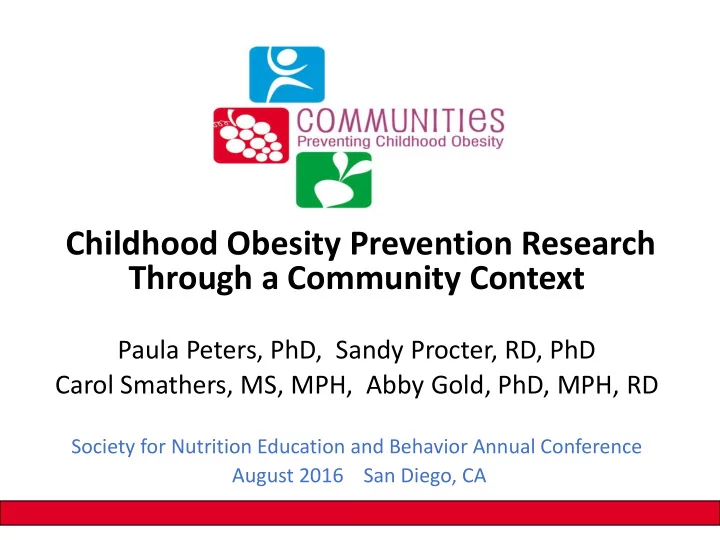

Childhood Obesity Prevention Research Through a Community Context Paula Peters, PhD, Sandy Procter, RD, PhD Carol Smathers, MS, MPH, Abby Gold, PhD, MPH, RD Society for Nutrition Education and Behavior Annual Conference August 2016 San Diego, CA
Project Overview Multi-state • IN, KS, MI, ND, OH, SD, WI Multi-disciplinary team • Nutrition • Physical activity • Community development • Family and youth development Funding • USDA Agriculture and Food Initiative (AFRI) Grant #2011-68001- 30100
Innovative Aspects 7 states collaborating Socio-Ecological Model of Childhood Overweight • Rural communities • Low-income families • Preschool aged children Community capacity development approach
Foundation Davison and Birch, 2001- Obesity Reviews 2, 159-171.
Situation Childhood obesity • Greater risk in rural areas • Greater risk in low income Obese by age 4 • Increased risk of being overweight or obese as an adult
Why Focus on Environment? • Growing evidence shows that environment is related to the incidence of obesity • Healthy choices need to be easy choices • Environmental changes can improve the health of the whole community, not just individuals
Choosing the Community • Two communities per state • Rural • Low Income • Population of 4 year old children • An active health-related coalition
Community Coaching One community per state assigned a “Community Coach” “A Community Coach: a guide who supports communities and organizations in identifying and achieving their goals.” (Emery, Hubbell, & Miles-Polka, 2011)
Project Goals 1. To empower rural communities to create and sustain environments that support healthy lifestyles for young children, with emphasis on good nutrition and physical activity . 2. Test community coaching model.
Approach – Methods 14 Communities • Selected Community coalitions identified as part of application • 1 intervention, 1 comparison community per state • Community coach hired and placed with intervention coalition
Funding Funding to each community annually, for 4 years Required: • one nutrition activity • one physical activity-related project
Assessment Tools • Socio-ecological Model of Childhood Overweight Assessment Toolkit • Active Where? Parents survey, initial + end • CHLI tools: Initial + end assessments • Coalition Self-Assessments : annually • Ripple Mapping : End • Reflections: Regularly • Post-intervention interviews: Coalitions and coaches • I nsights leading to “Best Practices ”
Active Where? Survey Parents of 4-year-olds completed a community assessment • At start and end of project • Team adjusted wording for rural, age application • Asks about physical surroundings, access to services, safety, physical activity • Gathered brief demographic data, etc.
CHLI - Community Healthy Living Index Three assessments: • Neighborhood • Early Childhood Program Assessment • Community-At- Large Conducted before and after Coalition members provided information
Coalition Self-Assessment Surveys • completed annually • queries aspects of being a coalition member and processes used • hard copy and electronic versions
Rip ipple le Ripple Effect Mapping Method used to better understand the “ripple effects” and relationships of this project on individuals, groups, communities, and regions.
Mapping Community Progress Ripple Mapping • Coalition Members • At the end of the project • Discussion was invited, recorded observed • Number of participants varied/state
Mapping process 1. Post a large piece of white paper on the wall and write “the project name” or purpose of the session in the middle of the map. (Some used Xmind to electronically record map) 2. Draw out several branches from the list identified 3. Ask and probe participants about the activities, programs, services, collaborations/connections, funding that resulted from the coalition’s work with our project - CPCO
Mapping Results – ND • North Dakota Intervention Community
Mapping Results – KS Control
Results Which capitals from the Community Capital Framework increase from community coaching? Human, Social, Political, and Built capitals were higher in coached communities: human capitals (89 vs 82 comparison commun) social capitals (108 vs 81 comparison commun) political capitals (27 vs 11 comparison commun) built capitals (29 vs 27 comparison commun)
Results What is the difference between coached and non-coached communities terms of the Socio- Ecological Model levels or rings? Coached communities employed more programs, services, and activities under the organizational, community, and public policy rings than the non-coached communities.
Results Is there a significant difference in the number of “ripples” between coached and non-coached communities? Yes, a difference was observed between the intervention and comparison communities. Total ripple score among intervention communities was 37 and among the control communities was 33.
Ripple Mapping We all came together, all the coalition members and our coach and the project director, and we went over all the different projects that we’ve actually done and realized that we did a lot more than we actually thought we did. So we just kind of looked at the big picture and thought “Oh, that was a good idea, that really worked out well” or “we really didn’t get much turn out for this type of thing ” – Coalition Member
Best Practices Online modules for community coalitions (http://go.osu.edu/CPCOtoolkit) 1. Readiness 2. Socio-Ecological Model 3. Using Evidence-Based Strategies 4. Evaluation 5. Community Coaching
Mobilizing Rural Communities to Prevent Childhood Obesity Screenshot of online toolkit Module 1
Insights Community Coaching is being “refined” • No “right” way Relationships and partnerships are essential • Coalition members • Coaches, staff, students Reflection is critical Sustaining community involvement over an extended time is challenging Working in 7 states is challenging, yet rewarding
Research Team Program Director: Paula Peters, PhD Co-Directors: Amy R. Mobley, PhD, RD, formerly Purdue University, IN Sandy Procter, PhD, RD, Kansas State University, KS Dawn Contreras, PhD, Michigan State University, MI Abby L. Gold, PhD, RD, North Dakota State University, ND Carol Smathers, MS, MPH, The Ohio State University, OH Renee Oscarson, PhD, South Dakota State University, SD Ann Keim, PhD, University of Wisconsin, WI Grant #2011-68001-30100, USDA, NIFA
Questions? Contact info: Paula Peters ppeters@ksu.edu Sandy Procter procter@ksu.edu Carol Smathers smathers.14@osu.edu Abby Gold abby. gold@ndsu.edu
Recommend
More recommend